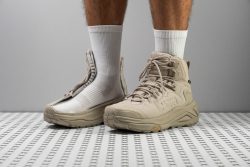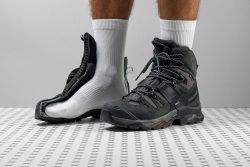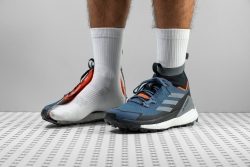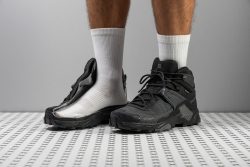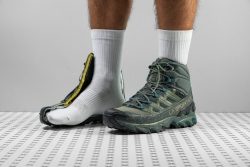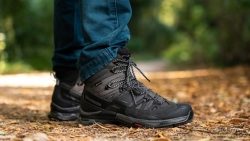7 Best Hiking Boots For Women in 2025
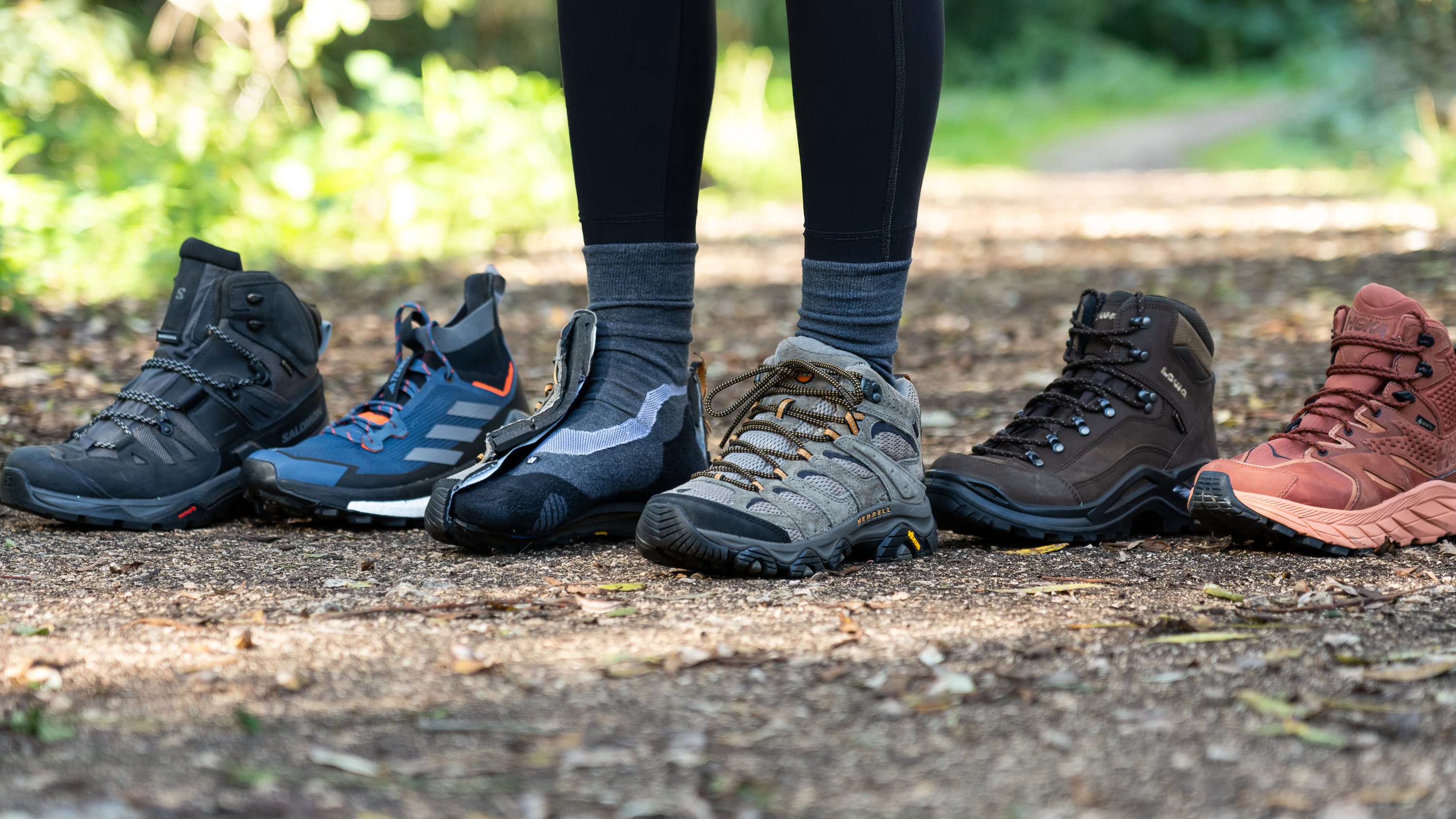
We buy shoes ourselves. We earn commissions when you buy through us, at no extra cost. Why trust us
Picking the ideal pair of boots for your outdoor adventures can be a real challenge. It's not just about finding boots that are affordable and great performers, but also finding those that fit great on our (female) feet.
Fortunately, we put these boots through various tests on the trails and in our lab, and we can now confidently highlight the best picks in different categories. And, if this is your first time buying hiking boots, we highly recommend reading the guide which covers all the priorities and little details.
How we test hiking boots for women
Here is our straightforward approach:
- We buy all the boots with our own money. We love being independent and publishing honest reviews.
- We put each hiker to the beating during wear tests. We pay attention to everything, from the comfort and fit, to the grip, durability, breathability, and stiffness.
- We also take the boots to the lab! Here, we take different measurements and compare them to average values to give context. We also cut the hiking boots in half and report on everything we find and test!
Best hiking boots for women overall
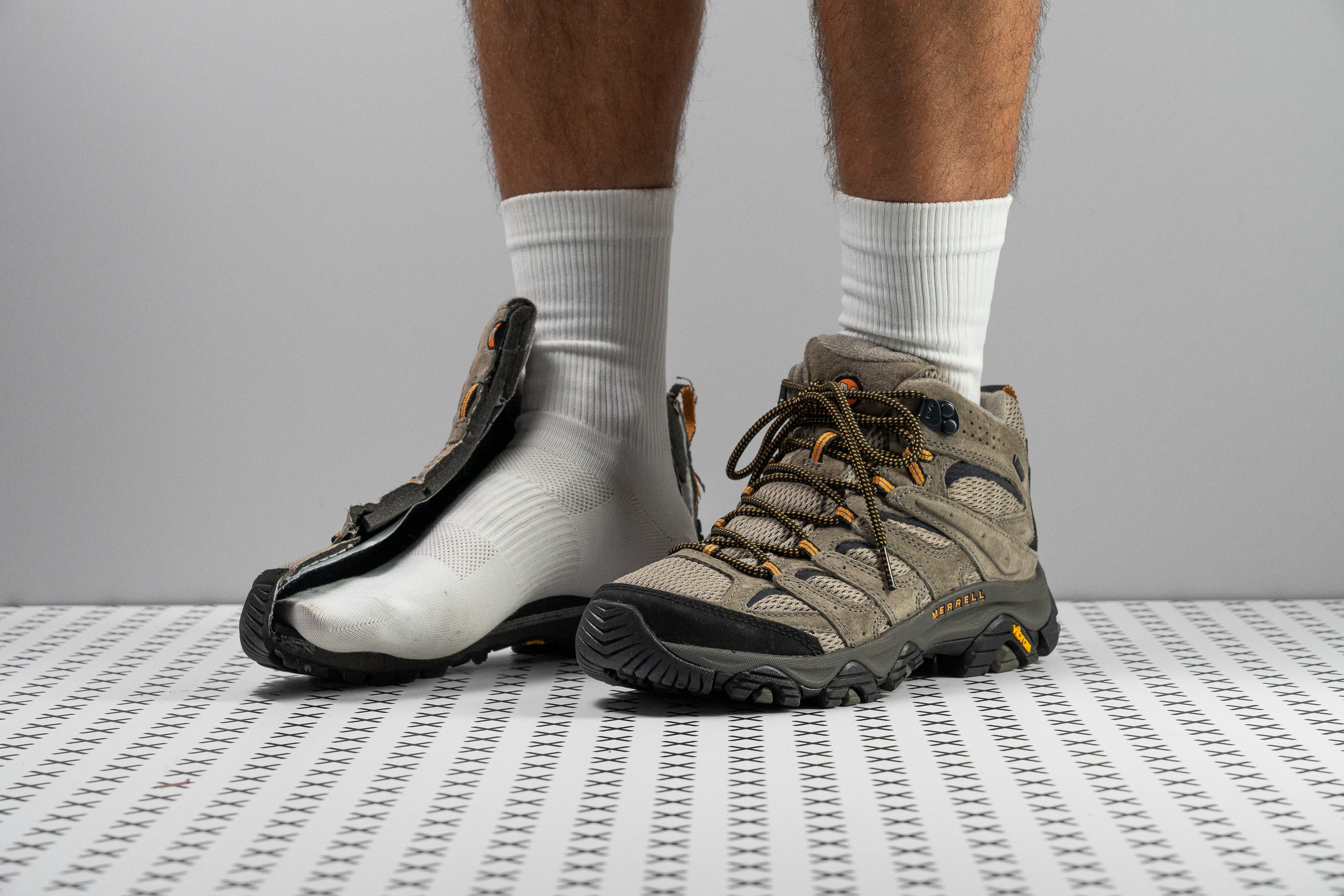




















































What makes it the best?
The Merrell Moab 3 Mid GTX filled our test hikes with comfort and support. It offers an effortless ride, ensuring confident strides as we navigate various terrains through its stable feel and reliable traction. Backed up by our lab results, it’s our top hiking boot for women.
The shoe felt really pleasant on foot because it was easy to maneuver. Our scales reveal it’s only 17.5 oz (495g), 7.6% lighter than the average hiking boot. Moreover, it has a loose build that flows with our movement. Our bend test confirms it’s 32.7% more flexible than average.
We remained surefooted through uneven paths due to the balanced 32.8 HA cushioning, 17.6% firmer than average. On foot, the foam feels softer than our durometer reading suggests because of the small and soft 24.6 HA Merrell Air Cushion in the midsole.
Underfoot, the Vibram TC5+ lined with deep 5.0 mm lugs does its job of keeping us in control through mossy logs and loose ground. However, while its traction is effective, the lugs are not toothy enough to handle mud and softer ground. Women who tackle these types of terrain need more aggressive lugs.
Pros
- Best-in-class waterproofing
- Great stability for moderate hikes
- Supportive for all-day wear
- Comfortable step-in feel
- Excellent grip on hard terrain
- Secure lockdown
- Sturdy construction
Cons
- Moderate impact protection
- Mesh panels are easy to tear
- Not for mud or soft terrain
- Moderate impact protection
Women's hiking boots with the best shock absorption
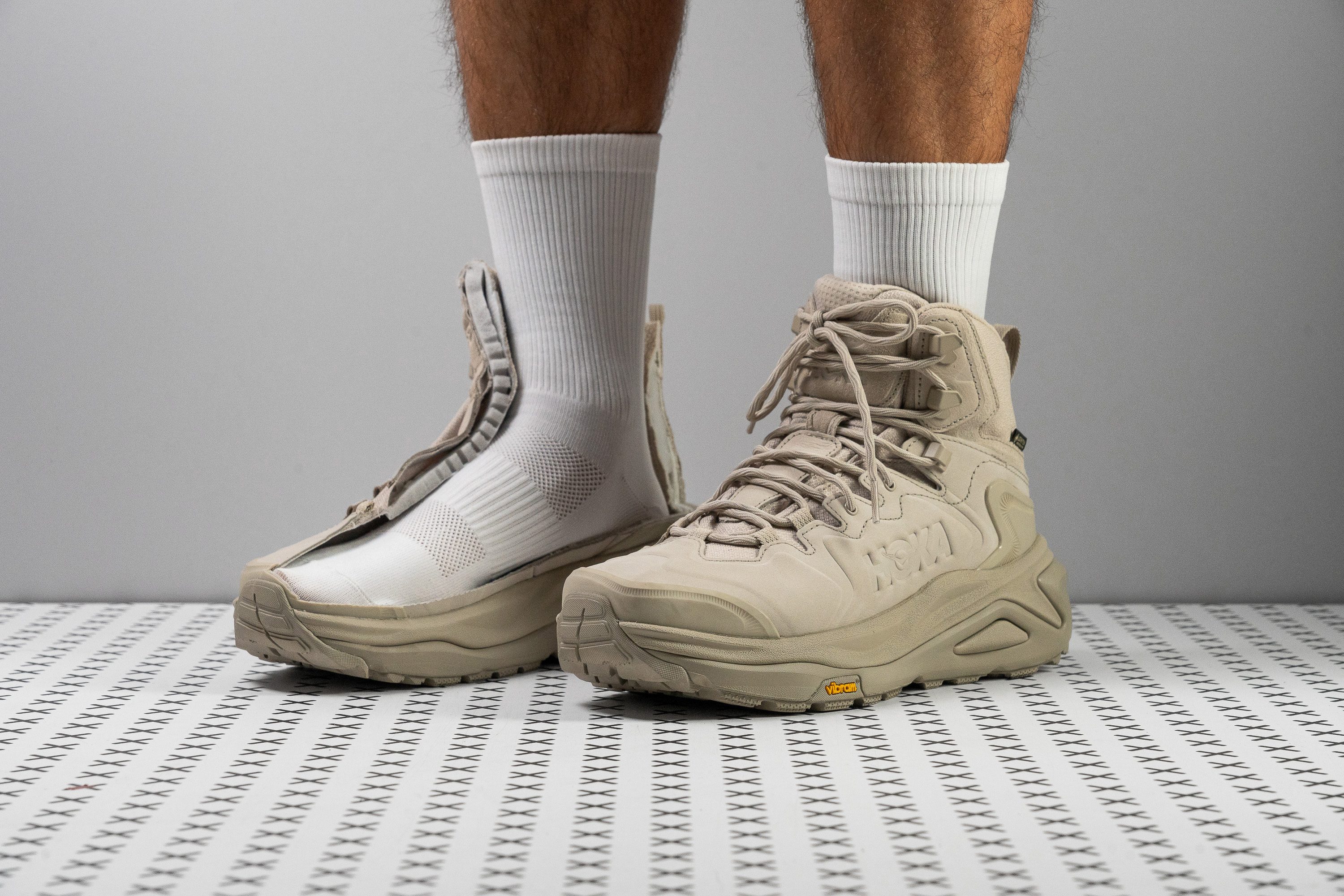
















































What makes it the best?
Hiking long distances feels easy in the Hoka Kaha 3 GTX because of its stable ride and indulgent comfort, which we confirmed through lab tests. Without a doubt, it’s the women's hiking boot with the best shock absorption, delivering leg-saving support gracefully.
We reveled in its cushioning during test hikes, with a stack measurement of 41.9/30.4 mm. The midsole offers gentle landings, which our shock absorption test backs up with an awesome 120 SA score, 29.0% more protective than average. Meanwhile, the SwallowTail heel, or the extended rear, enhances its smooth forward transitions.
Thankfully, the wide midsole inherently brought surefooted strides, which is a big help considering the shoe’s height. Our caliper validates its broad base with a 115.0/96.4 mm measurement.
In addition, the Vibram outsole enhanced control through its undeniable grip on our encounters with mossy or inclined surfaces. In our traction test, it earned an exceptional 0.65 rating.
Unfortunately, Kaha 3 GTX’s heavy build adds to our fatigue towards the end of the day, evidenced by its 19.4 oz (550g) figure on our scale. It would have been nice to have a boot that doesn’t increase the load for women.
Pros
- One of the best cushioned boots ever
- Extremely comfortable for long miles
- Highly stable and supportive
- Excellent traction on smooth surfaces
- Grips mixed and hilly terrain well
- Contains sustainable materials
- More streamlined than the Kaha 2
Cons
- Lugs got much shallower
- Heavier than average
Best backpacking boots for women
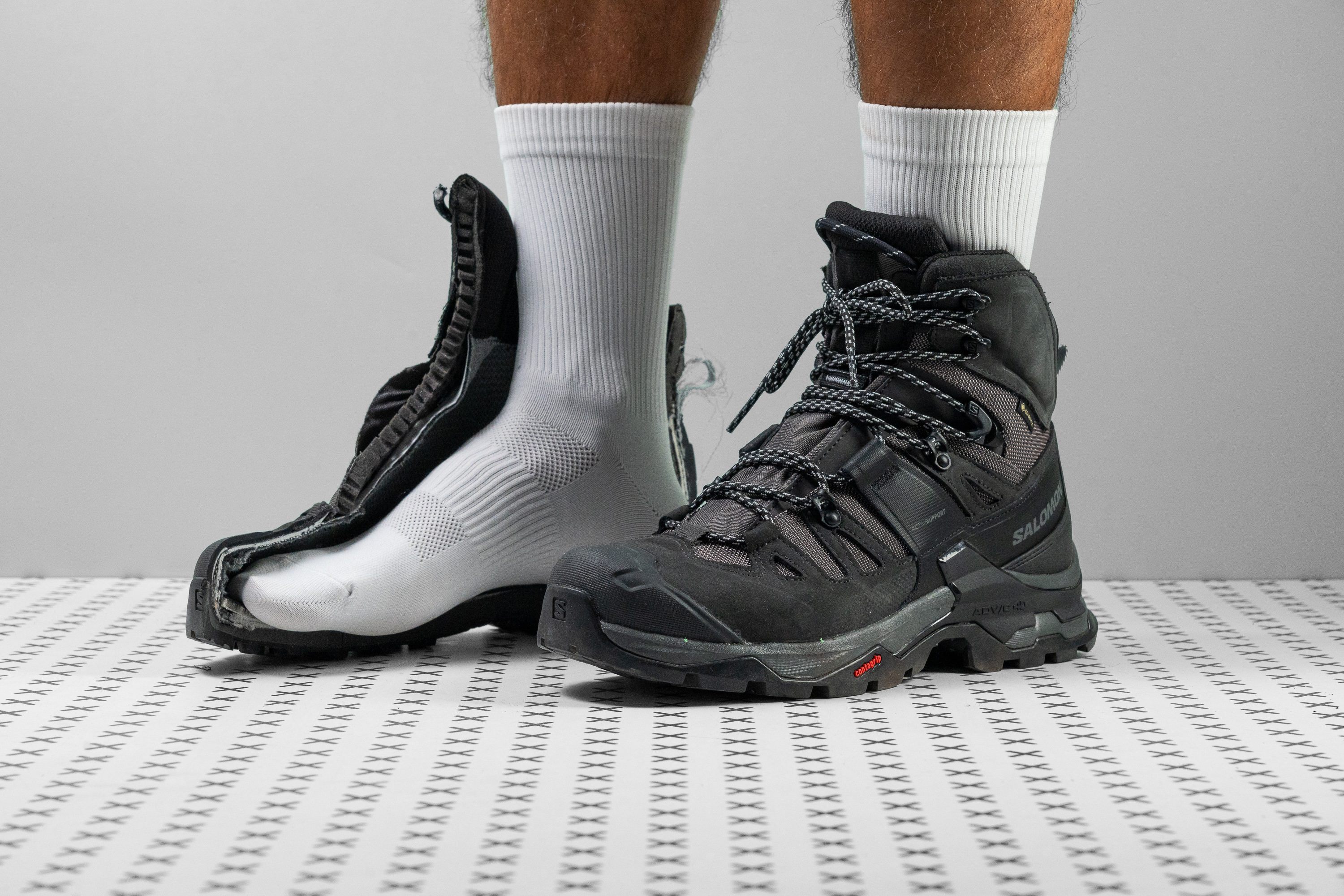















































What makes it the best?
The Salomon Quest 4 GTX is tough to beat in terms of the confidence and surefootedness it brings to our challenging hikes. Its sturdy construction and firm foothold make it our top backpacking hiking boot for women. From top to bottom, our lab agrees it’s a highly protective boot.
The Quest 4 GTX has unmatched steadiness due to the brand’s exclusive ADV-C 4D Chassis, which embraces our foot in place, and its stiff heel counter, which rated 5/5 in our manual assessment. These structured elements secure our foot alignment and reduce fatigue over time since they stabilize our steps for us. Plus, its 116.5 mm forefoot is wider than average, erasing any potential imbalances.
The upper is layered with sturdy materials such as Nubuck leather, Cordura-like textile, rubberized overlays, and the GTX membrane, which contribute to its bulletproof nature. Its 5/5 toebox durability rating further proves its ability to shield us in rugged terrains.
The Contagrip rubber in the outsole also proved its resistance to wear by showing less damage than average in our abrasion test. It includes 4.7 mm toothy lugs that effectively gripped various surfaces we tested.
The Quest 4 GTX is built like a tank and weighs like one too. At 23.4 oz (663g), it’s 23.7% heavier than the average hiking boot. Women with lighter loads on moderate terrains can opt for a lighter hiking companion.
Pros
- Exceptional durability
- Top-notch waterproofing
- Excellent underfoot protection
- Highly secure ankle support
- Fantastic stability
- Comfortable in-boot feel
- Effective grip on various terrain
- Fits as expected
Cons
- A bit heavy
- Gets very stiff in cold
Women's hiking boots with the best energy return
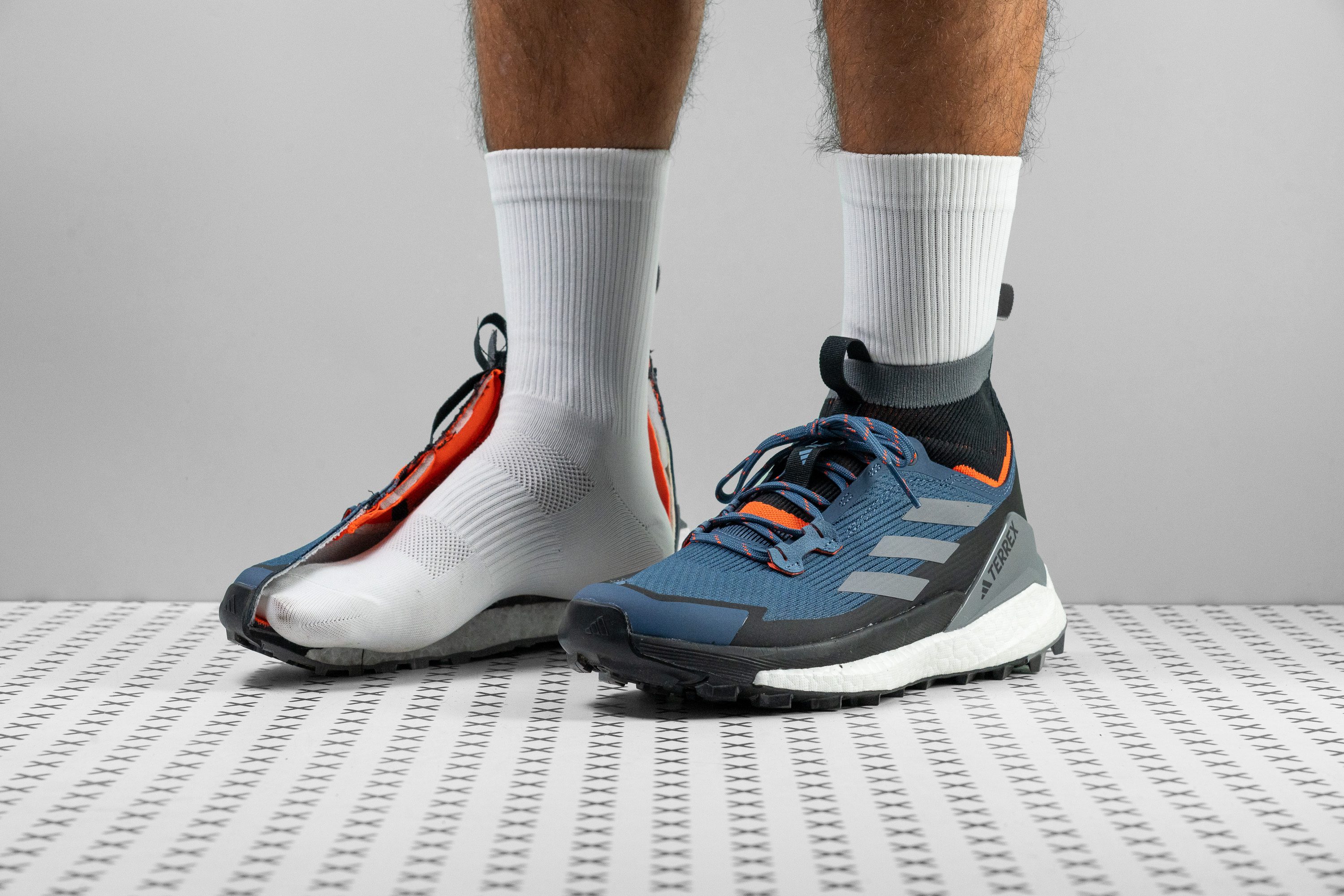













































What makes it the best?
On-foot testing with the Adidas Terrex Free Hiker 2 made us doubt we were wearing hiking boots. It has a swift and speedy persona that almost made us want to run because of its airy build, plush and peppy ride, and supportive outsole. Proven by lab tests, it’s our women’s hiking boot with the best energy return.
The midsole was a joy to test. It delivers a luxuriously comfortable ride with its high level of impact protection, confirmed by its 121 SA score in our shock absorption test. No matter how long we carried our backpacks, our legs felt well-protected. Each gentle landing is accompanied by springy toe-offs. Our energy return test verifies this with a high 66.0% score, 30.7% above average, perfect for women seeking an exciting ride.
Weighing 15.0 oz (425g), Terrex Free Hiker 2 rides like a trail shoe and is 20.1% lighter than the average hiking boot. Adding to its effortless feel is the subtle rocker that promotes faster and smoother transitions.
Underfoot, the Continental rubber proved its stellar standing by providing excellent traction during testing and beating the average in the lab for durability. While most boots get damaged by 0.80 mm in our Dremel test, this boot shed only 0.24 mm of rubber, proving it will last for many years.
However, its full comfort will be enjoyed after a break-in period. Women who plan to use this boot on long hikes should use it for shorter walks first.
Pros
- Extremely well-cushioned
- Exceptionally lively and bouncy underfoot
- Luxuriously padded interior
- Grippy and durable lugs
- Tackles wet surfaces confidently
- Very flexible and forgiving
- Excellent airflow
- Feels incredibly stable underfoot
- Supportive heel collar
- Rockered midsole
- Relatively lightweight
- High-quality construction
- Eye-catching design
Cons
- Needs breaking in
- Tricky to put on
- Expensive
Best leather hiking boots for women
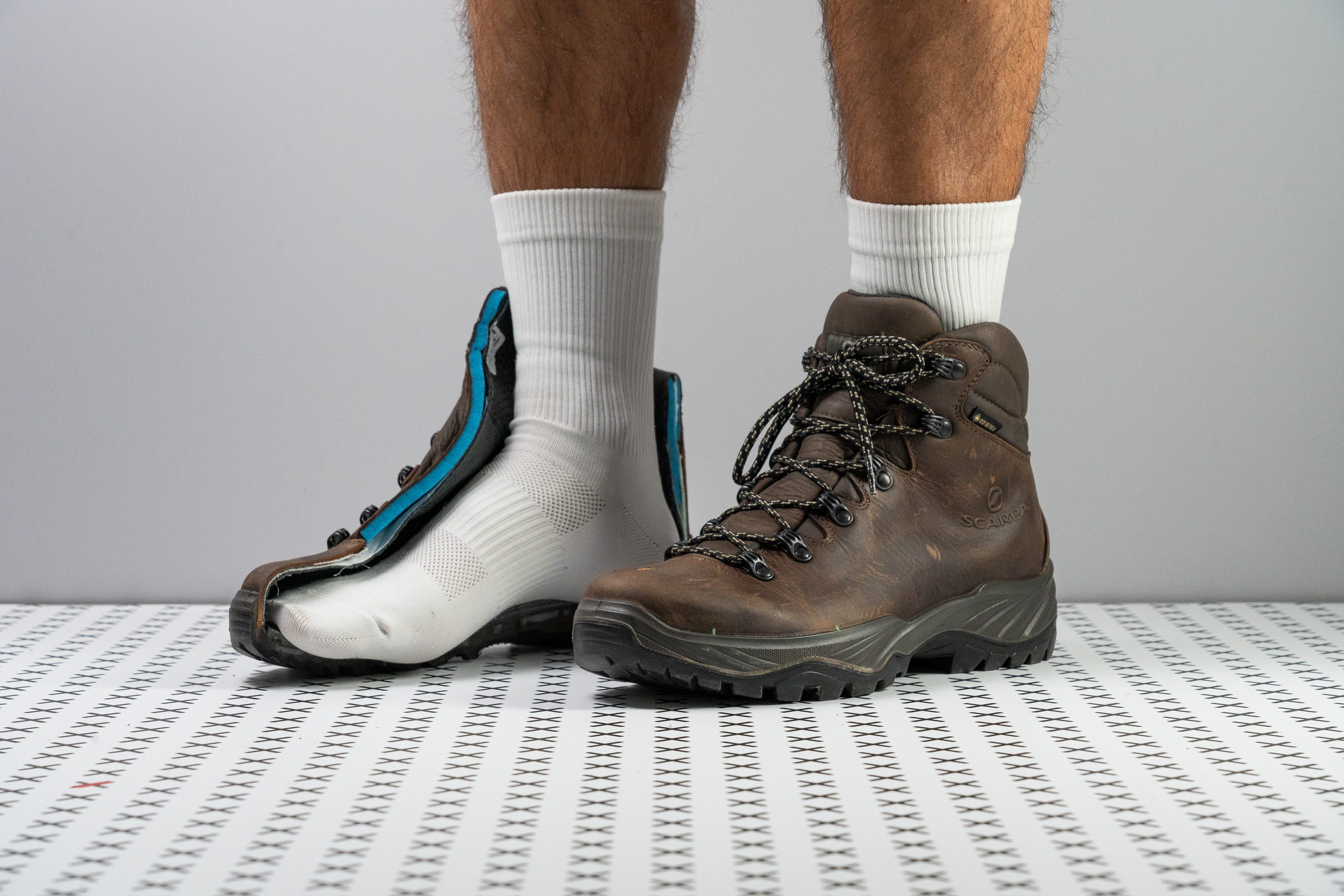







































What makes it the best?
No matter what path we took on our adventures, the Scarpa Terra GTX brought solid support and protection thanks to its high-quality leather. We felt sure of every step we took because of the Vibram outsole’s extra sticky traction. Post-testing in the lab, it emerged as our top leather hiking boot for women.
Visually, the leather upper looked waterproof, and our smoke test confirmed its airtight nature with a 1/5 breathability score, perfect for women who hike on cold and wet trails. Our microscope reveals a solid upper, it’s impossible for anything to get through. Even our Dremel is no match against it, earning it a well-deserved 5/5 toebox durability rating.
Besides its firm ankle hold, our surefootedness stems from the stiff TPU shank in the boot. The platform is also more grounded than average with its 32.1/17.0 mm stack, and firmer with its 29.5 HA midsole composition, all leading to a more stable ride.
The Vibram outsole shows glue-like adhesion even when we hiked through slippery slopes. The 4-mm lugs displayed solid braking power when needed. Overall, we’re amazed how Terra GTX manages to excel in both traction and durability, showing minimal damage in our Dremel test.
It’s no surprise that this leather boot is a hefty 20.3 oz (575g), which leads to leg fatigue over longer efforts. Women who prefer a more agile ride can try lighter options.
Pros
- Glue-like underfoot, even on wet surfaces
- Insanely comfortable
- Reliably stable and supportive ride
- Resilient and high-quality build
- Durable Vibram outsole
- Watertight and warm
- Quick break-in time
- Performs consistently in the cold
- Strong ankle support
Cons
- Quite heavy
- Cushioning could be better
- Scuff magnet
Women's hiking boots with the best stability
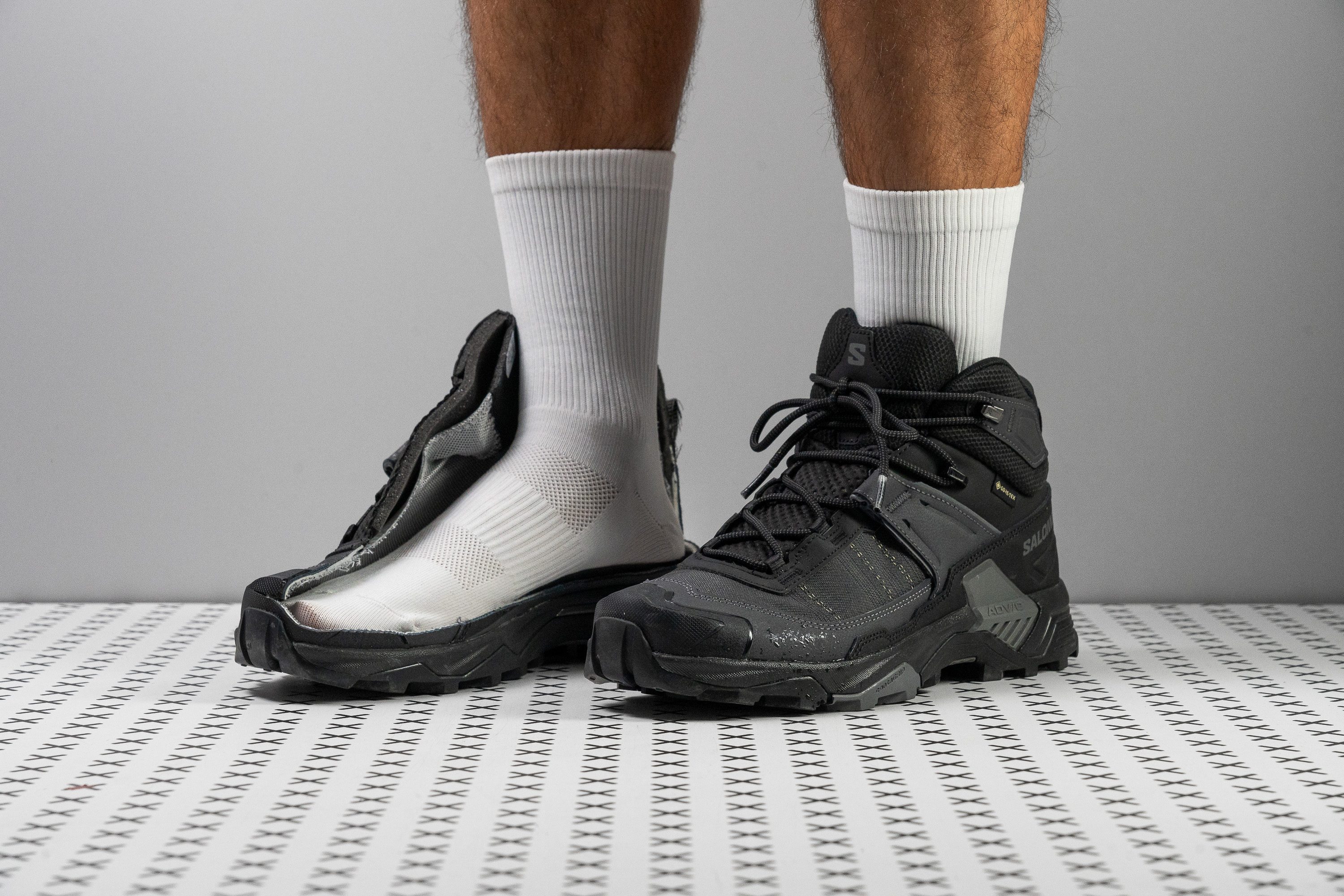











































What makes it the best?
With its sturdy support without adding much bulk and stiffness, we find the Salomon X Ultra Mid GTX as the ideal stability hiking boot for women. Lab results confirm it has no room for ankle twists with its Advanced Chassis and no room for slipping with its reliable Contagrip outsole. Thankfully, its light and pliable build helps keep our treks effortless and comfortable.
The Advanced Chassis is an unyielding TPU cage that wraps our midfoot, keeping us centered within the boot. It increases the shoe’s rigidity, proven by its 5/5 torsional stiffness rating, which prevents buckling over and losing balance.
The Contagrip outsole does a great job of keeping each step stable. In our traction test, it impressed with a 0.48 friction score, proving its effectiveness on mixed surfaces. It features 3.5 mm lugs with a pronounced heel brake that delivers stopping power during descents.
Despite its unwavering support, the boot never burdened us, making it perfect for women seeking a lightweight experience. Our scales confirm it’s only 15.4 oz (437g), making it 17.7% lighter than the average boot. Moreover, its forefoot is 34.3% more pliable than average in our bend test. This flexibility not only enhances comfort but also makes the boot easy to maneuver.
Unfortunately, this shoe will only feel stable for slim to medium-width feet. The midsole runs slightly narrower than average, so we recommend that wide-footed women find a more accommodating shoe.
Pros
- Stable and grounded platform
- Flexible forefoot adds maneuverability
- Great grip on wet terrain and rocks
- Surefooted on mixed and hilly trails
- Much lighter than average
- Excellent Gore-Tex waterproofing
- Tough and durable upper
Cons
- Minimal cushioning and shock absorption
- Not for deep mud
Best lightweight hiking boots for women
















































What makes it the best?
The La Sportiva Ultra Raptor II Mid GTX shows grace under pressure during our lab assessments and wear tests in the mountains. It offers a smooth yet controlled ride through its effective impact protection, resistance to excessive motions, and grippy base. And, it does so in a minimal build, making it our best lightweight hiking boot for women.
Starting strong, this boot only weighs 14.6 oz (415g), a mind-blowing 21.8% lighter than average! It never burdened our steps, and it’s significantly felt on foot after multiple hours of trekking, since fatigue doesn’t set in right away.
It also offers good shock absorption in its grounded profile. With a score of 94 SA in our shock absorption test, it carried us through the day without feeling too sore since it makes each landing feel gentler, helping alleviate any joint pain for women.
The base offers control and precision through its strong traction and stable ride. It features deep 4.3 mm lugs that can handle various surfaces and elevation changes, while its high torsional rigidity (5/5) prevents any chances of losing balance.
Note that this boot has streamlined dimensions to maintain its low figure. Women who prefer a wider platform, whether for better comfort or stability, should go for another boot.
Pros
- Unbelievably lightweight
- Excellent waterproofing
- Doesn't let debris and falling rain/snow inside
- Exceptionally robust and durable
- Phenomenal grip on technical terrain
- Not so stiff and firm in low temperature
- Sufficient impact protection
- Highly supportive collar
- Ample flexibility
Cons
- Narrow platform
- Not for wide feet
How are women’s hiking boots different than men’s?
This entirely depends on the brand! While there’s a generalized rule that says women’s feet are wider at the forefoot and narrower at the heel, that’s not something we get to confirm in all hiking boots. Usually, it’s best to try the boots on! And, if you’re wearing a size that also exists in men’s hiking boots (once converted), you’re in for a treat because you get to choose which one you want.
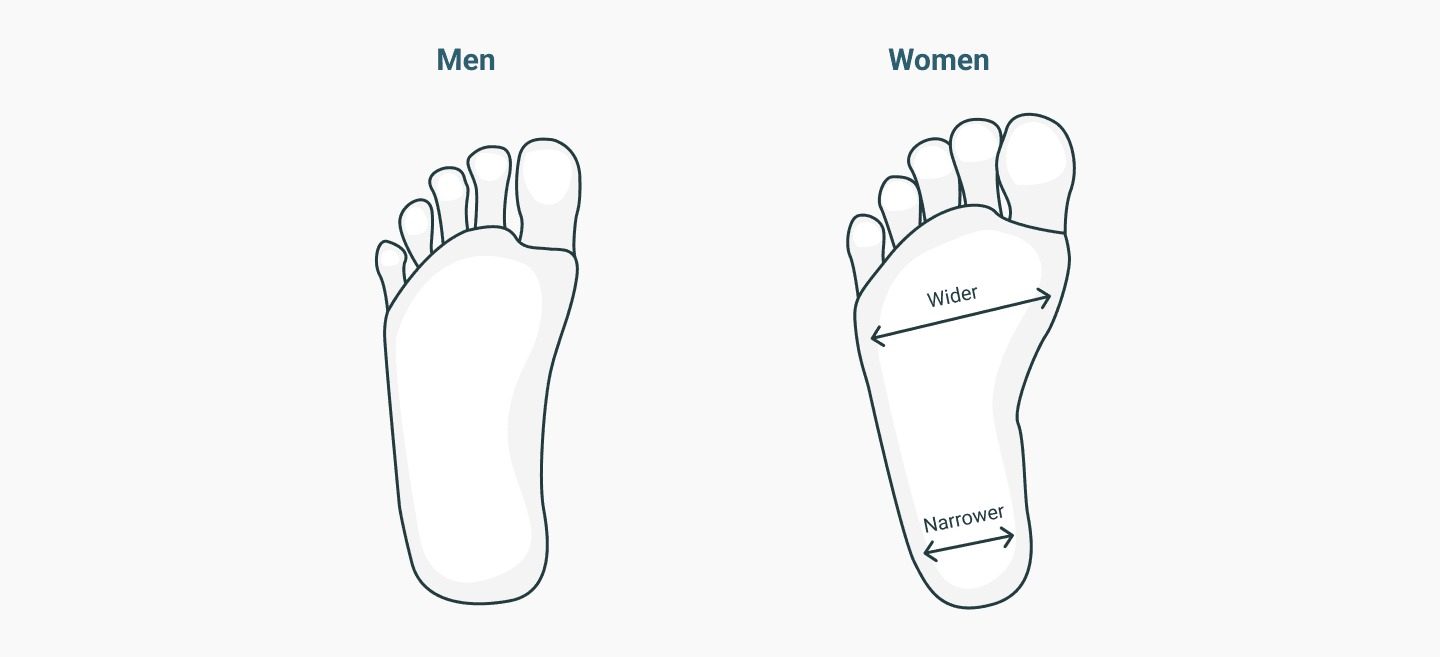
Next to the width, we could also expect some brands to change the midsole because women weigh less, so their midsoles can be designed for lower impact forces. This can be reflected in the different softness of the midsole and shock absorption of the midsole.
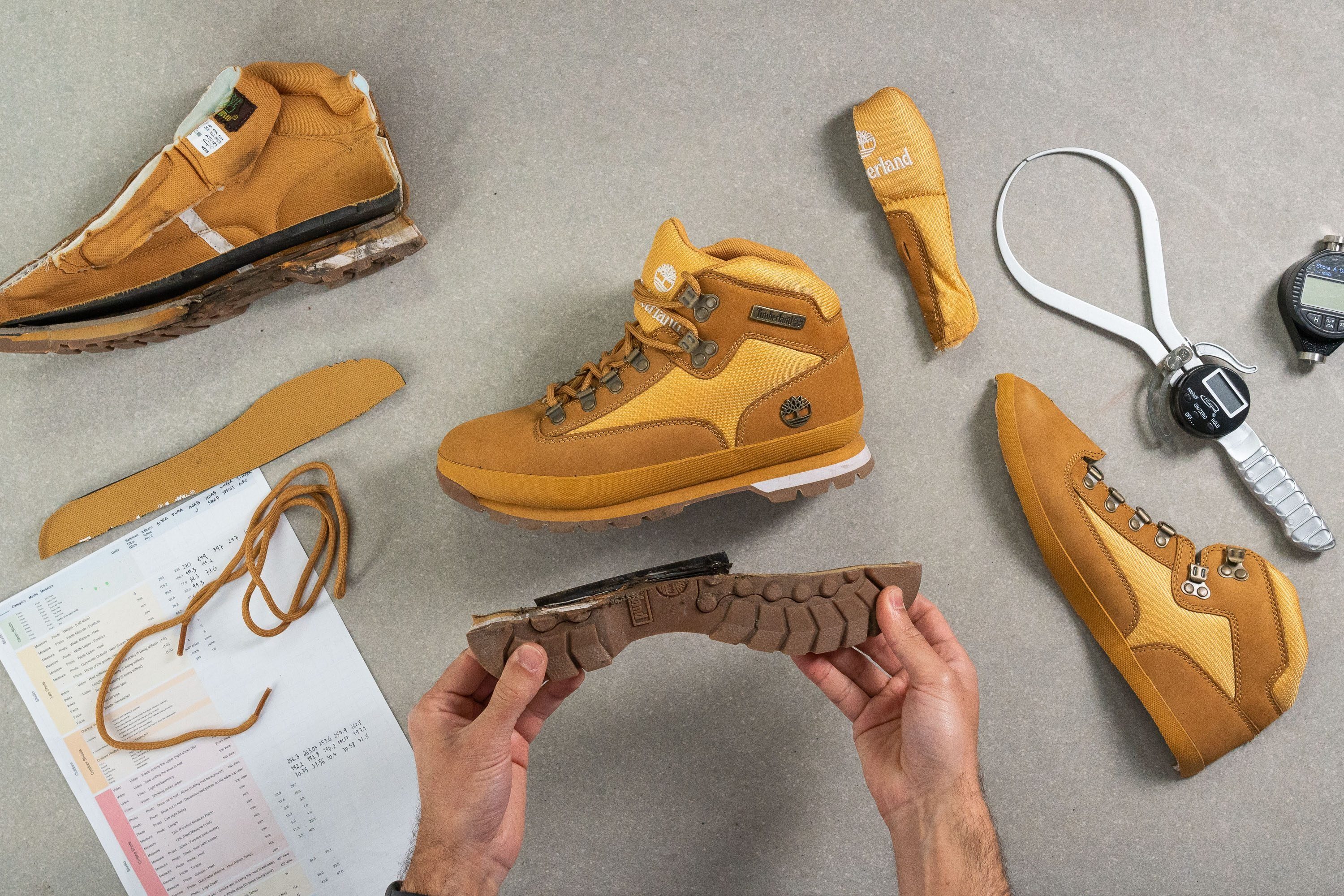
Make sure you need boots and not hiking shoes or trail runners
Getting hiking boots is a great idea when you need footwear that will offer more protection, support and stability than hiking shoes or running shoes. Hiking boots are usually way tougher and keep your ankle secured.
If you’re having second thoughts, here are the main reasons women choose different footwear for hiking:
- Hiking shoes instead of boots: great if you don’t need your ankle secured or you’re not hiking in deep snow. Hiking shoes can also be much more flexible and breathable than hiking boots.
- Trail running shoes instead of boots or shoes: great if you want to be fast and agile. Trail shoes are more flexible than hiking shoes and boots, can be much more breathable, and they are great when you’re aiming for a fast & light hike.
Boot recommendations for women who are just entering the world of hiking
If you’re planning to buy your FIRST EVER pair of hiking boots, here’s what we suggest:
- Don’t buy minimalist hiking boots, but cushioned ones. That means looking for a shock absorption of at least 85 SA.
- Choose a mid-range lug depth of 4-5 mm. This will work on most terrains, even moderately demanding ones!
- Look for lighter hiking boots (less than 500g or 17.6 oz), as heavier ones can cause premature muscle fatigue if you’re not used to such activities. Heavier ones might also offer much more than you need as a beginner, in terms of protection, insulation, and durability.
5 things to pay attention to when buying women’s hiking boots
Hiking boots have many features but we showcase here 6 things you should pay attention to, especially if you’re just entering the world of hiking:
- Fit of the boot, which includes nailing the length, width, and everything in between
- Deciding on the hike difficulty. This one is very important because it basically dictates all the other features like lug depth, protection, durability, and so on.
- How stable should the boots be? This depends on the terrain, your pronation, and the weight of the backpack you plan to carry.
- Season: should boots be breathable or warm? Waterproof or water repellent? There are boots that you can wear all-year round but it’s important to think the weather through.
- Do you plan to hike over sharp rocks or deal with the obstacles on the trails? To translate this to the hiking-lab-tests world, do you need an especially protective and durable toebox or the outsole?
We will cover each of these bullets below and take a deeper dive into the topic of hiking boots.
1: How to nail the fit in women’s hiking boots
We always recommend following these 4 steps when buying new hiking boots. Fit is everything so it’s important to prioritize it and spend enough time on finding the perfect one.
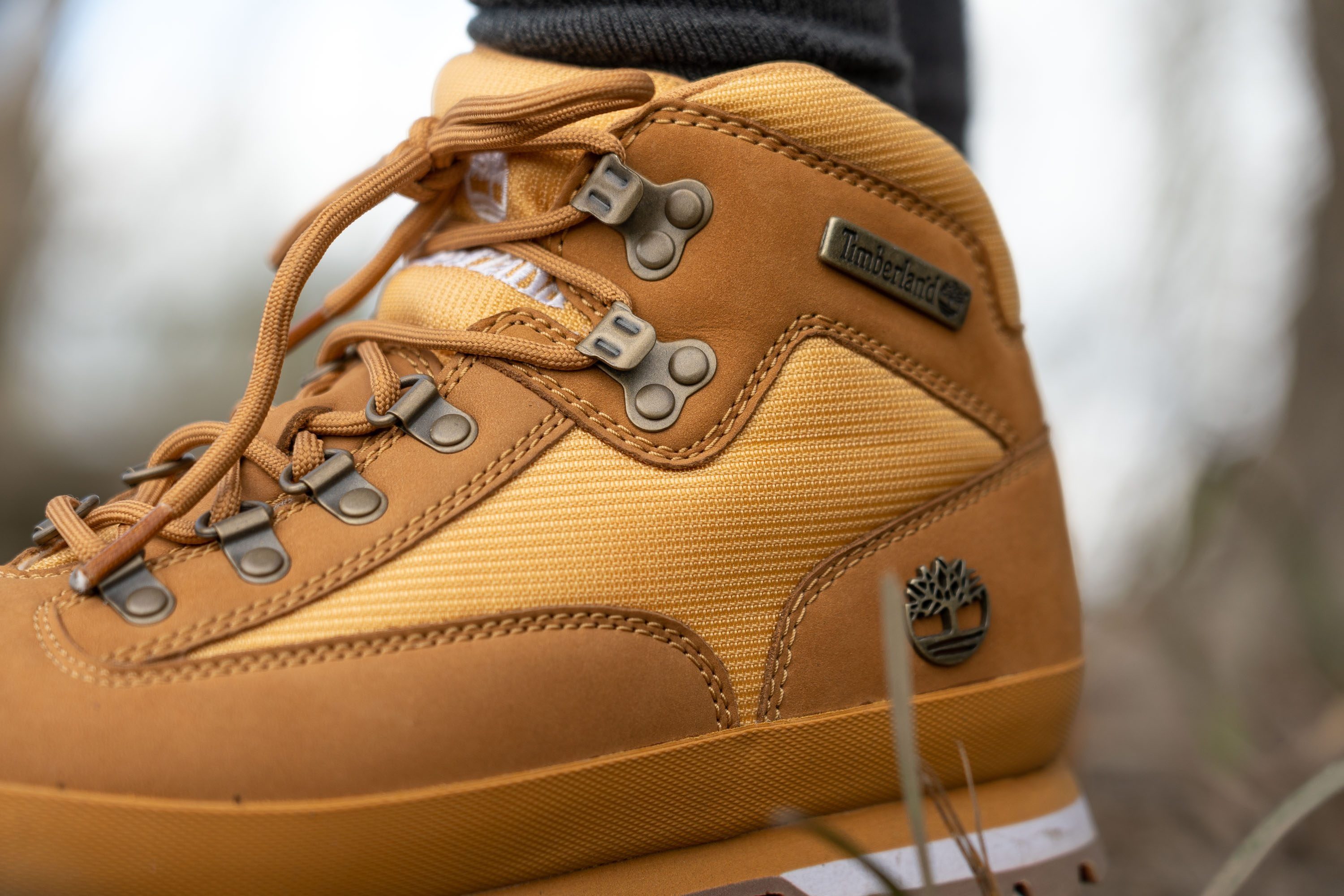
- You should go shopping for hiking boots later in the day, afternoon or evening. We recommend this because, by then, our legs are swollen a bit from the whole day of activities and that’s exactly what we need. Swelling happens naturally on the hikes, so trying the boots on early in the morning, when your feet are fresh, does not make sense.
- Try the boots on with the hiking socks that you usually wear when hiking (or plan to wear) and orthotics (if you’re using them).
- Once you’ve laced the boots, check for hotpots. There should be no pressure points on the one hand, and, on the other hand, there should be no sliding within the boot or heel slipping. The boots should fit comfortably, not too tight and not too wide. If you’re in a specialized store, test the boots on different surfaces and ramps (going uphill, downhill, over large rocks, grass, etc.).
- When you push your foot forward to reach the toebox with your big toe, there should be one thumb’s width of room behind your heel. Or, if you glue your heel to the back, you should sense as much space in front of your big toe.
Once you’ve nailed the fit, keep in mind that many hiking boots need to be properly broken in. Don’t rush doing a 30-mile backpacking hike without walking in them shorter distances first.
Wide toebox in women’s hiking boots
In case you have a wide forefoot, it’s best to look for hiking boots with a wide toebox. Because not every lady has the same shape of feet, we measure the shoe width in 2 places.

This helps us understand its width (obviously) and how much it tapers! Pointer toeboxes are narrower at the big toe.
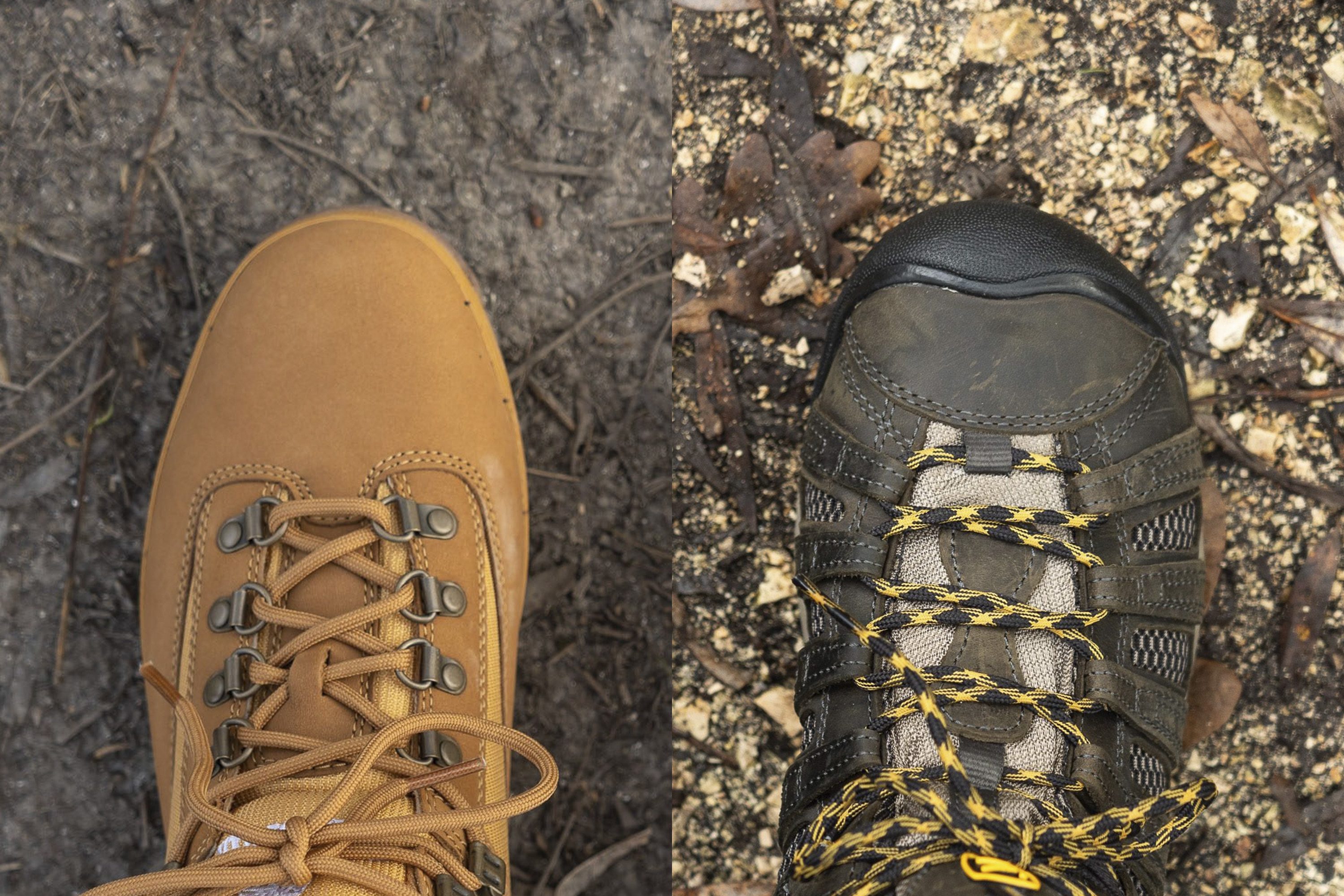

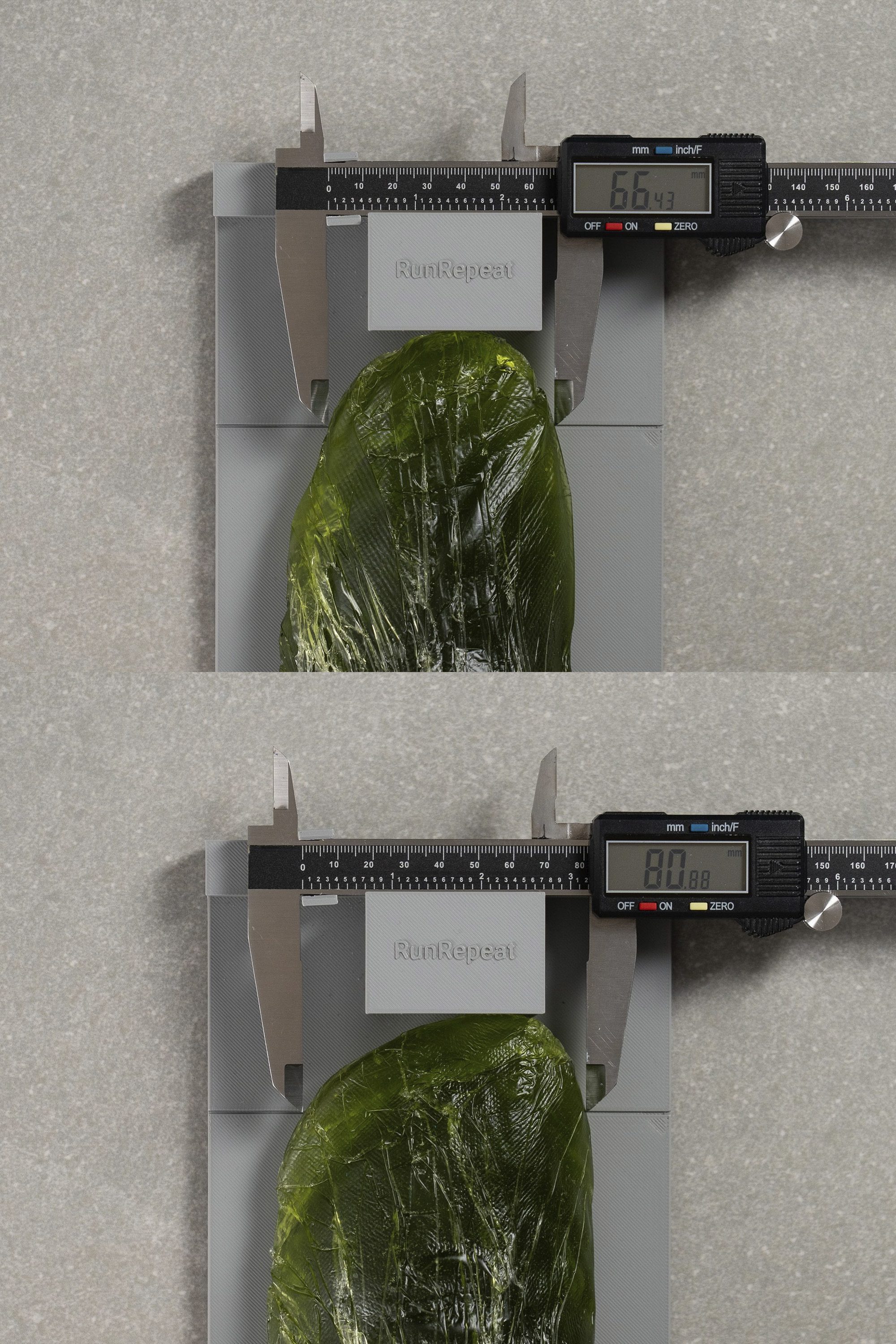
If you need more width around the big toe (meaning you prefer the least pointy boots), here are toeboxes that are the widest at the big toe:
In case you need width around the ball of the foot, these are the boots with the widest toeboxes in that area:
And, if your big toe is pointing up, or you often feel the pressure from the top of your toes, we recommend finding high toeboxes.

2: Determine hike difficulty (light, moderate, technical)
Generally, we can split the hikes into 3 groups: light, moderate, and technical. Here’s what we consider them to be:
- Light hiking: you’re going for an easy hike. The terrain is not demanding, you’re not wearing a heavy backpack, and you might even want to mix it in with urban hiking (boots that look good enough to hit the city in them). These boots can be flexible, pliable, and quite not protective. These hiking boots are sometimes mid-cut because they don’t need to offer the highest level of protection and support.
- Moderate hiking: you want to tackle moderate trails, which means you need somewhat deeper lugs that are able to bite into the ground, that is different from easy hard-packed trails. This could be a multi-day hike over demanding terrain, covering smaller muddy areas or single tracks covered with lighter debris. These boots are often protective and stiffer.
- Technical hiking asks for the most rugged hiking boots with deep lugs. These boots are the most protective, and the stiffest because they should be extra stable and supportive and have the best grip for soft and loose terrain, mud, slush, or terrain covered with tree roots, pebbles, and other obstacles.
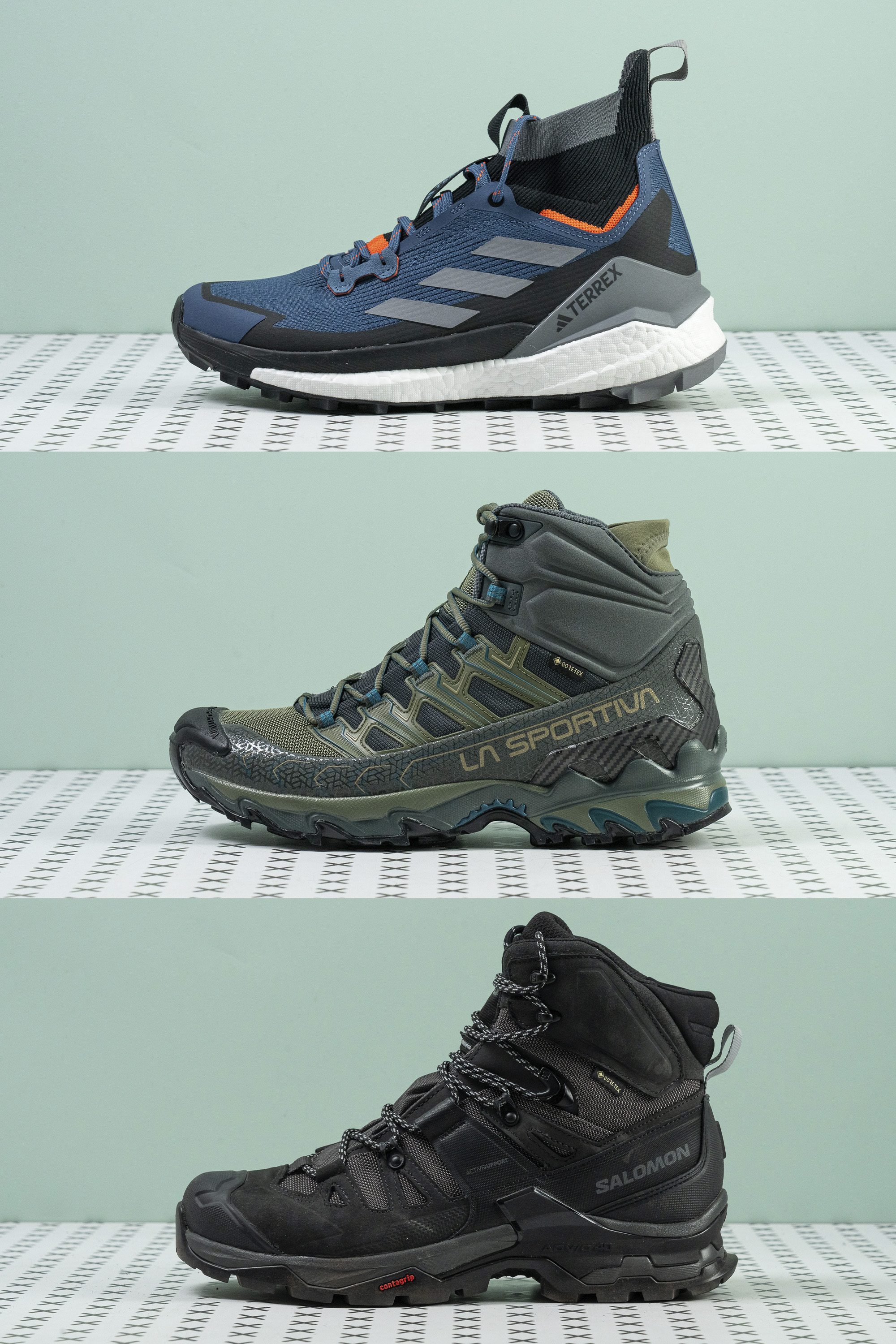
Keep in mind that, if you’re planning to do high-altitude hiking, you should also consider mountaineering boots. These boots have extra insulation layers, can be deeper (higher up the leg), and can withstand harsher conditions (ice, snow, freezing temperatures) for longer periods of time with your feet not freezing in them.
3: Grip and lug depth in women’s hiking boots
When we talk about grip, we cover 3 things: the thickness of the lugs, outsole thickness, and the hardness of the outsole rubber.


When measuring the hardness of the rubber, it’s important to note that the higher numbers on the durometer indicate a harder rubber and lower numbers mean the rubber is softer. Harder rubber is more durable and protective, while softer rubber is stickier.

Depending on the terrain, we split women’s hiking boots into 3 groups:
- Boots for light hiking usually have lugs shallower than 4 mm
- Boots for moderate hiking have lugs in the 4-5 mm range
- Boots for technical hiking have lugs deeper than 5 mm
These numbers tell us a lot about the difference between the boots and women’s trail running shoes because, in the world of trail runners, shallow lugs are around 2 mm, while thick lugs are deeper than 4 mm.
|
Footwear |
Average lug thickness |
|
Trail running shoes |
3.5 mm |
|
Hiking shoes |
3.9 mm |
|
Hiking boots |
4.2 mm |

This means that, usually, the deeper lugs mean the boots are ready for more demanding terrain. However, there can be some overlap because it’s not just about the lugs. Some boots are chunky and focused more on the style, so even if they have deeper lugs, they shine best at light hiking. Other boots can have mid-range lug depth but an aggressive slimmer design which makes them great for technical terrain.
4a: Breathable or warm hiking boots?
First things first: hiking boots, high-quality ones, especially heavy hiking boots, are not as breathable as, say, running shoes. Different materials come into play, plus boots must be more protective. So, when boots are very breathable, they are so in the hiking realm.
Testing the breathability of women’s hiking boots in RunRepeat lab
We test the breathability of hiking boots by filling them with smoke and then watching where it comes out and at which pace. We then assign a 1-5 breathability score to each boot. 5 is the most breathable!

We also have a look at the uppers under the microscope. Some of these images are so spectacular we want them on our desktop backgrounds. These insights allow us to better understand what’s happening, breathability-wise.
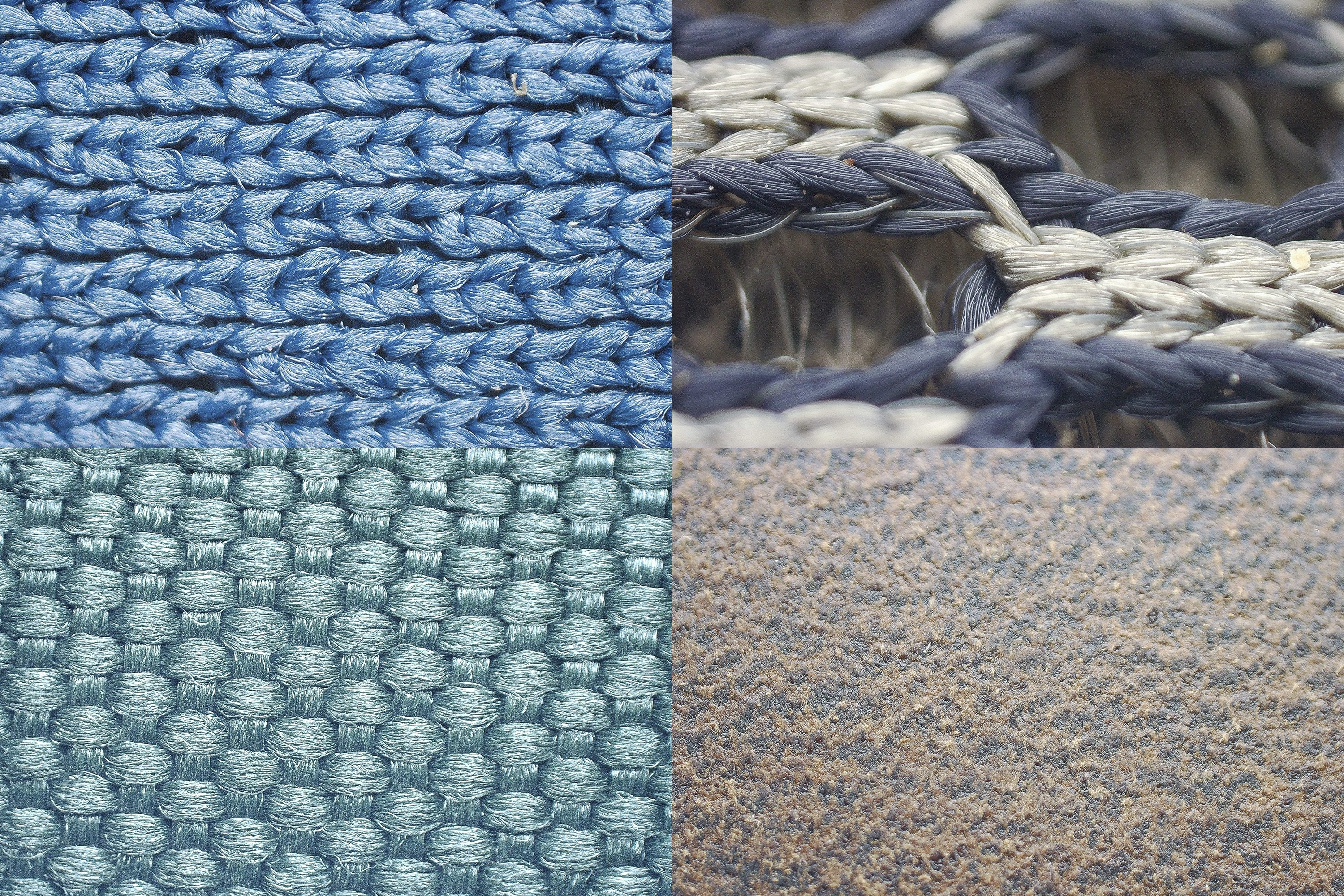
In case you plan to hike in hot weather or have sweaty feet, it’s best to look for breathable hiking boots. In this case, we also recommend getting thin wool or bamboo socks as they have antimicrobial and moisture-wicking properties.
For context, the average breathability of hiking boots is 1.45, while the same average for hiking shoes and trail running shoes sits at 2.72 and 3.34, respectively.
If you usually hike in cold weather, worry not because we have a list of the least breathable hiking boots for you right here. If you also want these boots to be waterproof (maybe you’re hiking in rain, snow, slush), move on to the next chapter.
4b: Waterproof hiking boots for women
There are a few DOs and DONTs we should cover here. You SHOULD opt for waterproof hiking boots if you plan to hike a lot in wet weather. Maybe you'll be crossing streams, hiking through tall wet grass, or simply hiking when it’s raining or snowing.
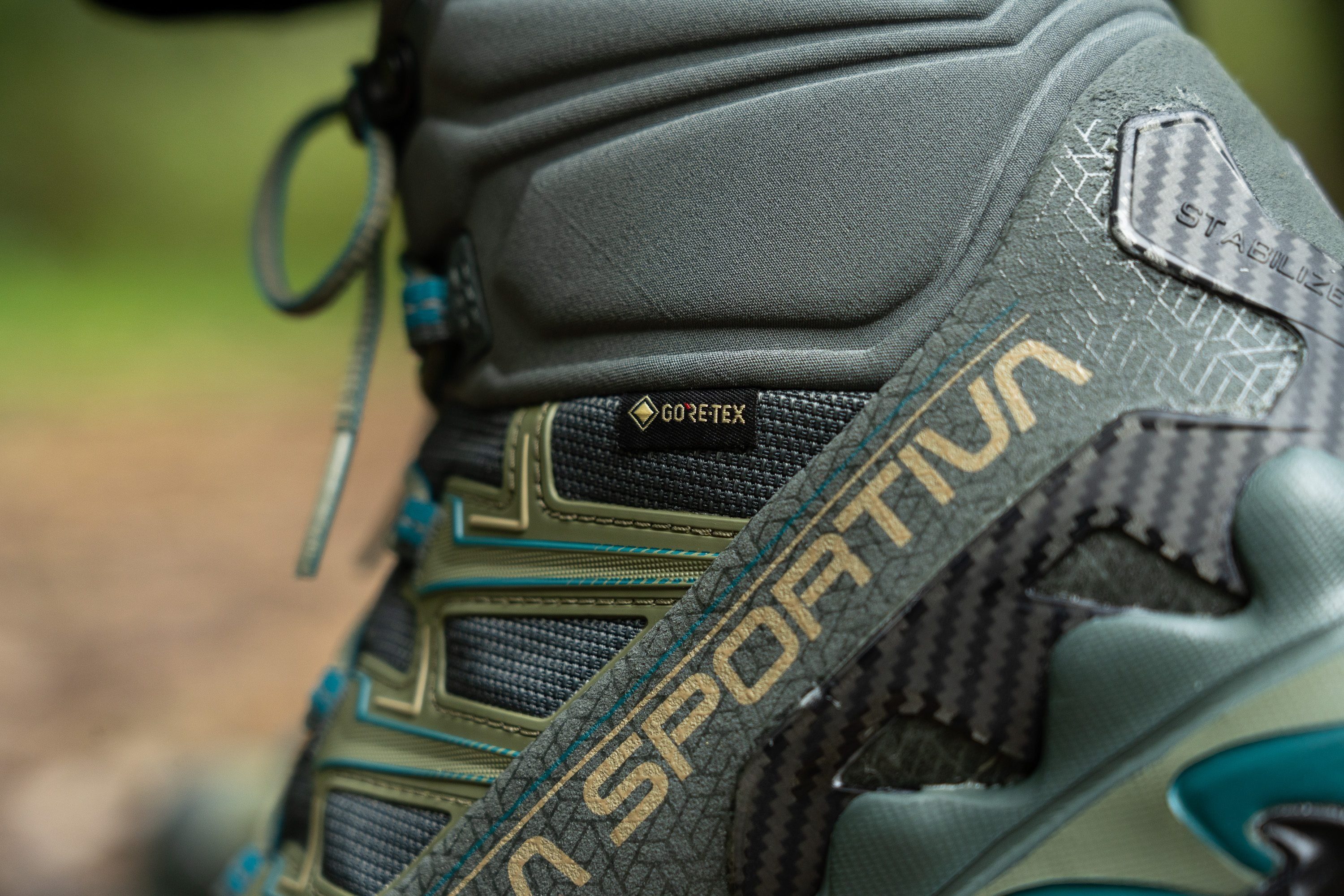
If not on the boot, you can find the waterproof/GTX note on the box.
You should NOT choose waterproof hiking boots if you think those would be breathable or if you might run into only a few wet areas. Waterproof hiking boots are a) more expensive and b) less breathable than the non-waterproof ones, so if you don’t really need them, best to choose the regular ones.
Keep in mind that water can still get into your boots if it slides down your trousers. If you anticipate that happening, best to look for waterproof gaiters. For more advice on waterproof hiking boots, we wholeheartedly recommend our guide: Best Waterproof Hiking Boots.
5: Shock absorption and energy return of hiking boots for women
We recommend finding cushioned and not minimalist hiking boots because they make sense for beginners. Minimalist hiking boots ask for a transition period and patience. Cushioned hiking boots are boots that have good shock absorption, which means they scored at least 85 SA on our lab test.
Testing the shock absorption and energy return of women's hiking boots
Shock absorption tells us how protective the midsole is it may not be about the protection you have on your mind. It's not about debris and sharp obstacles, but how good it is at dampening the impact when you land on it. The better the shock absorption, the lower the stress sent to hikers' legs!
While not directly related to shock absorption, it's also important to look at energy return. What good can a high-SA midsole do to you if its energy return is ridiculously low? This would mean that the midsole is dull. It does not recover from being stepped on quickly and it tires your feet. Good energy return feels responsive and lively, on the other hand.
6: Durability of women’s hiking boots
Ladies who are doing research on the durability of hiking boots are usually the ones who already had their boots fall apart prematurely or who know they will seriously abuse the boots! And, we’re here to answer all the questions.
In our lab, we test the durability of the a) toebox, b) heel padding, and c) outsole. For these tests, we use a dremel which we press against the surface. These tests are standardized, meaning that for each, we always use the same pressure, RPMs and time duration.
Testing the durability of the toebox on women’s hiking boots
Once we’re done with the dremel, we look at the damage and assess the rating on a 1-5 scale, where 1 is the least durable and 5 the most durable. We use the same principle to assess the damage of the heel padding.
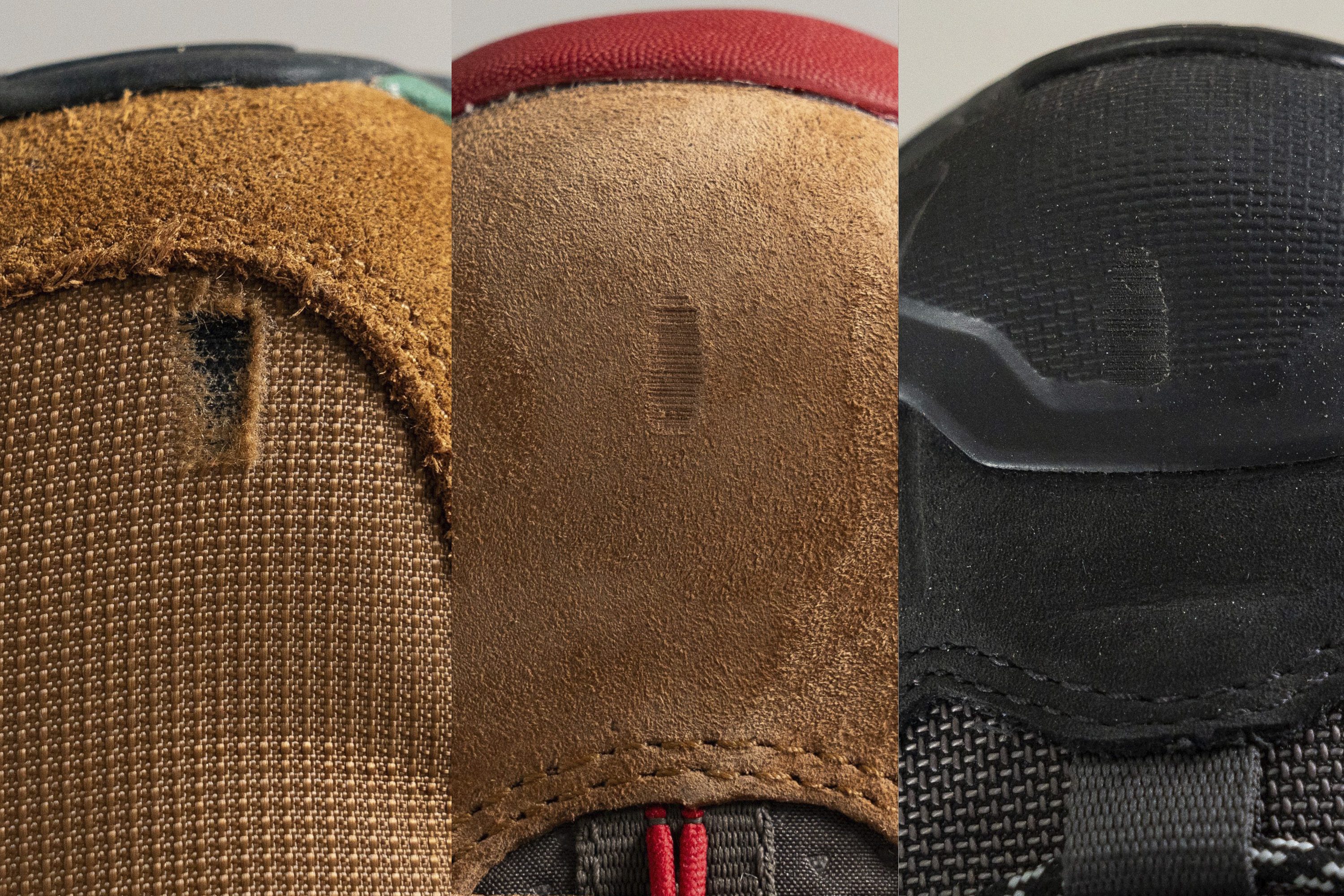
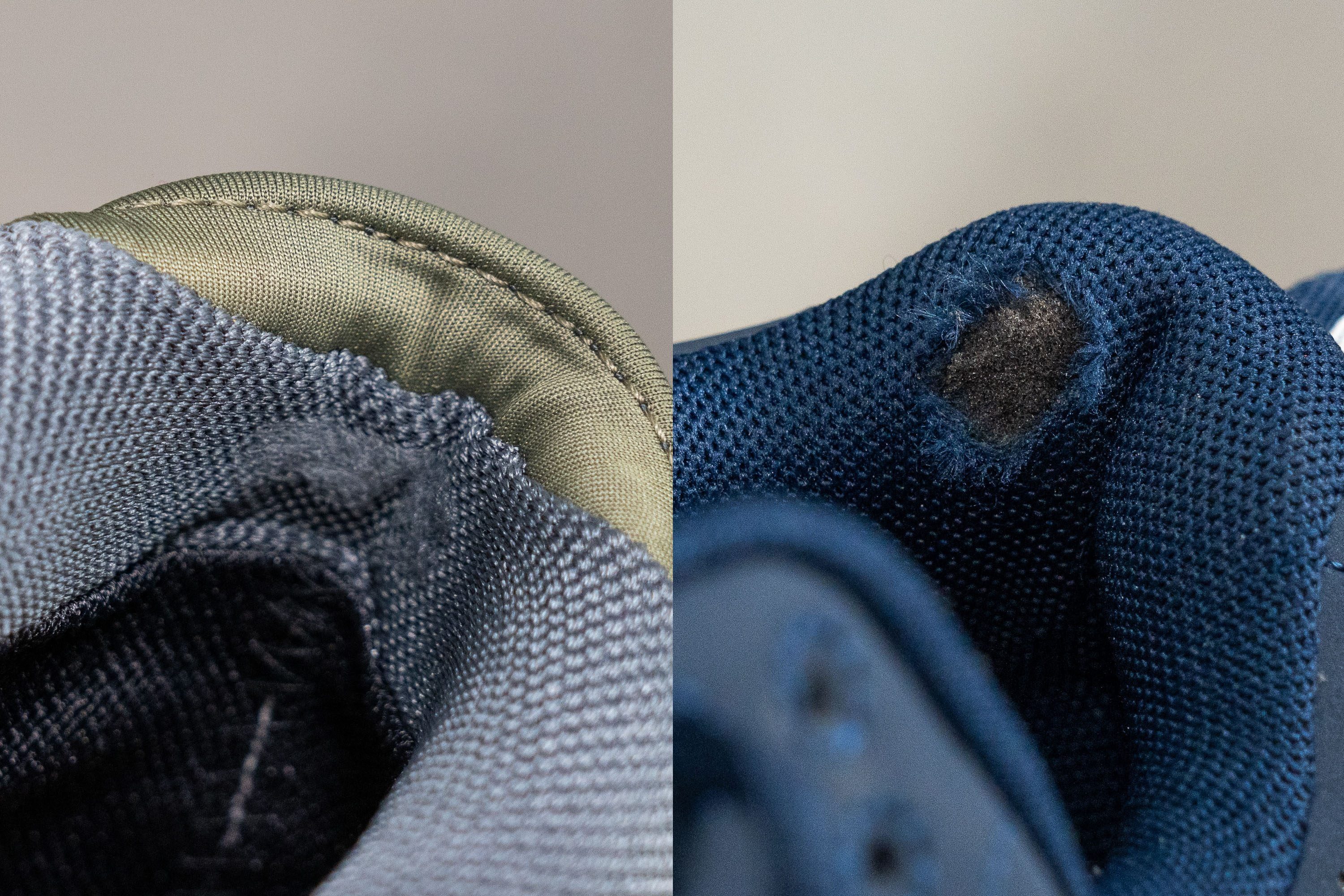
However, when we test the durability of the outsole, we don’t have to assess the damage because we can measure it precisely.
Testing the durability of the outsole in RunRepeat lab
We use a tire tread gauge to measure the dent we made on the outsole, the deeper the dent, the less durable the outsole.

Heel drop in boots is wildly different from trail running shoes
If you’re coming here from the world of trail running shoes, you should be knowledgeable about the difference in heel-to-toe drop between running shoes and hiking boots.
For context, here’s our current lab data (at the moment of writing this guide):
|
Trail running shoes |
Hiking shoes |
Hiking boots |
|
|
Min heel drop |
-0.1 mm |
-0.8 mm |
2.6 mm |
|
Max heel drop |
17 mm |
16.0 mm |
20.9 mm |
|
Average heel drop |
7.7 mm |
11.1 mm |
14.0 mm |
Being aware of these changes is important because heel-to-toe drop utilizes different leg muscles depending on its height. Just like zero drop running shoes utilize the foot muscles the most, the high-drop shoes utilize the highest leg muscles, like hip muscles. To learn more about this, please read our Ultimate guide on heel to toe drop.

Pregnancy and hiking boots: what to choose
While we covered the majority of features in hiking boots, if you’re pregnant, it’s very important to look for a stable hiking boot. You will gain weight and stability and support are your priority.

Stability is about the width and stiffness of the platform. It’s best when the platform is wider and stiffer, so that there’s no wobbling!
We also measure stiffness in our lab by bending the boot to 30 degrees after adjusting for its forefoot rocker.
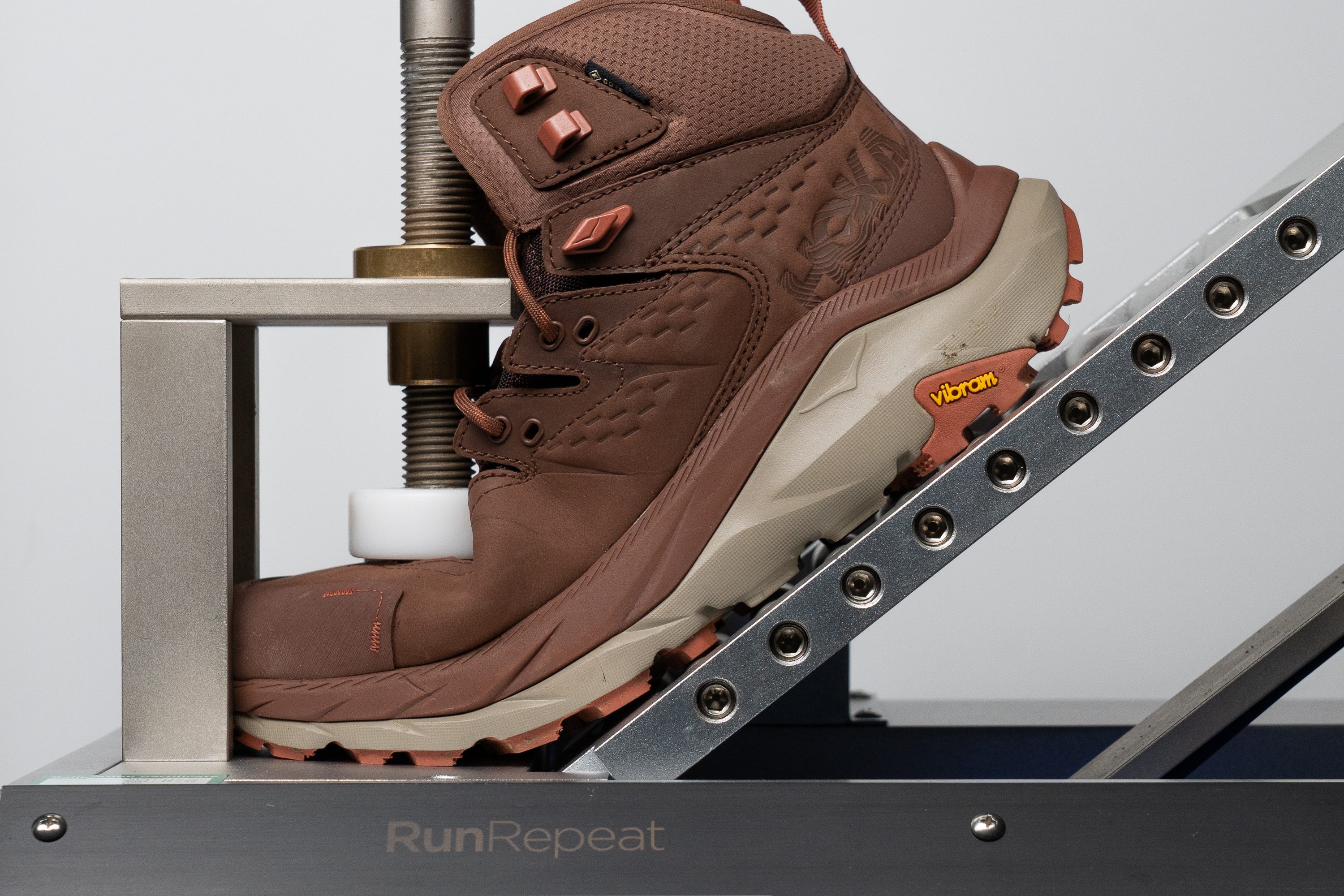
Women wearing men’s or unisex hiking boots: sizing
If you found what you want in a boot that’s available in men’s or unisex hiking boots, it’s important to check the sizing. Given that conversions can vary, you can:
- Use a conversion size chart https://runrepeat.com/size-charts/danner
- Or find your size in the men’s chart by looking at the length (given in cm). This is the most accurate approach that applies to all footwear categories and switches between men’s, women’s, and unisex footwear.
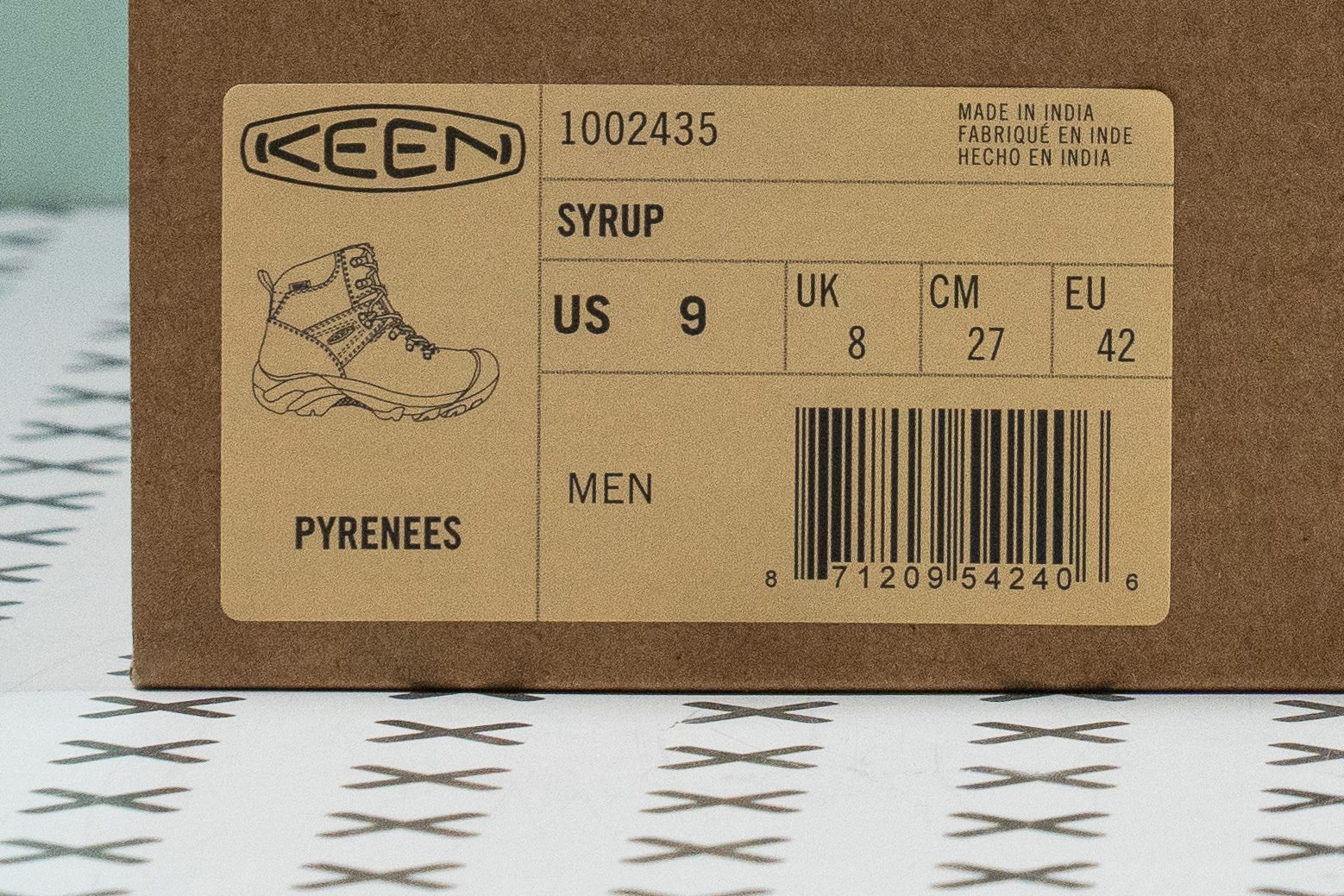
Also good to know
Now that we’ve covered almost everything, and you feel like you could soak more knowledge in, here are 3 details you can pay attention to when buying hiking boots:
- Find out whether the insole/lining is antimicrobial. This comes in handy especially if you have sweaty feet.
- Find out if the boots can be resoled. Some brands offer this, so as long as the upper (usually made of leather) is in good condition, you can have your boots resoled at a fraction of the price of a new hiking boots pair.
- If you plan to enter even more demanding hiking waters, which means you’ll have to wear crampons for a better bite on ice and snow, you should look for crampon compatibility. There are different crampon types and, therefore, different compatibility options. Whether you’ll be able to put the crampons on your boots is information you can find on the boot box.


